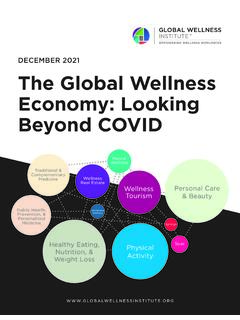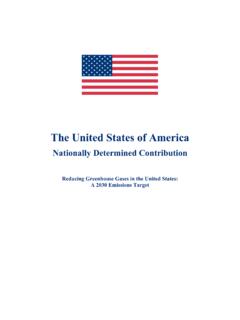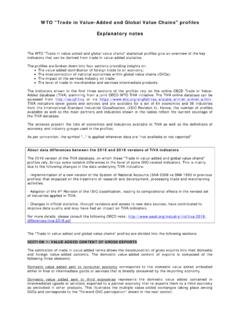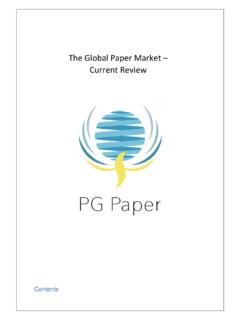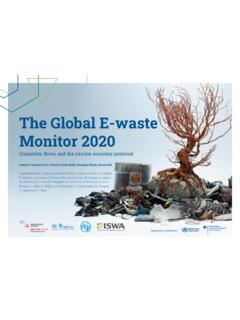Transcription of Global Wellness Tourism Economy
1 Global Wellness Tourism EconomyNOVEMBER 2018 Global Wellness Tourism EconomyNOVEMBER 2018 Copyright 2018 by the Global Wellness InstituteQuotation of, citation from, and reference to any of the data, findings, and research methodology from this report must be credited to Global Wellness Institute, Global Wellness Tourism Economy , November 2018. For more information, please contact or visit SummaryiFull Report1 Preface3I. The Rise of Wellness Tourism5II. Five Key Things to Know About Wellness Tourism9 III. The Wellness Tourism Economy21IV. Emerging Business Models and the Future of Wellness Tourism33V. Regional Highlights41 Asia-Pacific43 Europe49 North America53 Latin America-Caribbean57 Middle East-North Africa61 Sub-Saharan Africa65 Appendix A: Countries Currently Promoting Wellness Tourism69 Appendix B: Acknowledgements75 Industry Research Sponsors77 ABOUT THE AUTHORSABOUT THE Global Wellness INSTITUTEThe Global Wellness Institute (GWI), a 501(c)(3) non-profit organization, is considered the leading Global research and educational resource for the Global Wellness industry and is known for introducing major industry initiatives and regional events that bring together leaders and visionaries to chart the future.
2 GWI positively impacts Global health and Wellness by advocating for both public institutions and businesses that are working to help prevent disease, reduce stress, and enhance overall quality of life. Its mission is to empower Wellness worldwide. THE AUTHORSThe Global Wellness Tourism Economy report was prepared by Ophelia Yeung and Katherine Johnston, Senior Research Fellows at the Global Wellness Institute. Together, they have four decades of experience leading research and strategy development for businesses, universities, research institutions, and multilateral and government organizations under the auspices of SRI International, a Silicon Valley-based technology and innovation company. Since 2008, Ms. Yeung and Ms. Johnston have worked with the team at what has become the Global Wellness Institute to pioneer groundbreaking research on the Global Wellness Economy and its subsectors.
3 They were assisted in this research by Tonia Callender, GWI Research Wellness Tourism EconomyExecutive SummaryNOVEMBER 2018 Global Wellness Tourism Economy November 2018 | iii258mTrips204mTrips59mTrips11mTrips7mT ripsLatin America-Caribbean$ ExpendituresSub-SaharanAfrica$ ExpendituresMiddle East-North Africa $ ExpendituresNorth America$ ExpendituresEurope$ ExpendituresAsia-Pacific$ Expenditures292mTripsSource: Global Wellness Institute, Global Wellness Economy Monitor, October 2018 Wellness Tourism by Region, 2017 Number of Wellness Tourism trips and expenditures (inbound and domestic)Source: Global Wellness InstituteEXECUTIVE SUMMARYW ellness Tourism is travel associated with the pursuit of maintaining or enhancing one s personal wellbeing. GWI estimates Wellness Tourism is a $639 billion Global market in 2017, growing more than twice as fast as general 2013, the Global Wellness Institute (GWI) unveiled the inaugural edition of the Global Wellness Tourism Economy report a landmark study that defined the parameters and characteristics of the emerging Wellness Tourism sector, estimated its Global size, and highlighted its far reaching economic impacts.
4 Since then, this Tourism segment has accelerated around the world. This updated Global Wellness Tourism Economy report revisits the framework and definition presented in the inaugural report and provides new data and insights on Global , regional, and country-level developments. Estimated at $ billion in 2017, Wellness Tourism is a fast-growing Tourism segment that has been growing by annually from 2015-2017 (more than twice the growth rate for general Tourism ). Travelers made 830 million Wellness trips in 2017, which is 139 million more than in 2015. Growth has been driven by an expanding Global middle class, growing consumer desire to adopt a Wellness lifestyle, rising interest in experiential travel, and increasing affordability of flights and travel options.
5 Across regions, Europe remains the destination for the largest number of Wellness trips, while North America leads in Wellness Tourism expenditures. Asia has made the most gains in the number of Wellness trips and Wellness Tourism expenditures, with demand stimulated by strong economies and an expanding middle class. Wellness Tourism by Region, 2017 Number of Wellness Tourism trips and expenditures (inbound and domestic)iv | Global Wellness InstituteSecondary Wellness travelers account for the bulk of Wellness Tourism trips and growth: 89% of trips and 86% of Wellness Tourism market includes two types of travelers: primary Wellness travelers, who are motivated by Wellness to take a trip or choose their destination based on its Wellness offerings ( , someone visiting a Wellness resort or participating in a yoga retreat); and secondary Wellness travelers, who seek to maintain Wellness or engage in Wellness activities during any kind of travel ( , someone who visits a gym, gets a massage, or prioritizes healthy food when they take a trip).
6 The bulk of Wellness Tourism is done by secondary Wellness travelers, who account for 89% of Wellness Tourism trips and 86% of expenditures in 2017. Secondary Wellness Tourism also continues to grow at a faster rate than primary Wellness Tourism , at 10% compared to 8% annually, from Wellness travel dwarfs international Wellness travel, but international Wellness trips have been growing , domestic travel accounts for 82% of total Wellness Tourism trips and 65% of expenditures. International Wellness trips represent a proportionally larger share of expenditures because the average level of spending for an international trip is much higher. International Wellness Tourism trips have also been growing at a faster pace (12% annually) than domestic Wellness Tourism trips (9% annually) from and Domestic Wellness Travel Lead In Trips and ExpendituresArrivals/TripsSecondary Domestic74%(611m trips)Primary Domestic9%(74m trips)Secondary International15%(129m trips)Primary International2%(17m trips)Receipts/ExpendituresSecondary Domestic56%($360b expend.)
7 Primary Domestic9%($57b expend.)Secondary International30%($191b expend.)Primary International5%($32b expend.)Note: Figures may not sum to total due to rounding. Source: Global Wellness InstituteGlobal Wellness Tourism Economy November 2018 | vWellness Tourism is high-yield travelers spend more per trip than the average tourist, and this holds true for both domestic and international travelers. In 2017, international Wellness tourists on average spent $1,528 per trip, 53% more than the typical international tourist. The premium for domestic Wellness tourists is even higher. At $609 per trip, they spend 178% more than the typical domestic tourist. Wellness Tourism Spending Premiums, 2017 Wellness Tourism Spending Premiums, 2017 Estimates by the Global Wellness Institute, based upon Tourism industry data from Euromonitor : Global Wellness Institute, Global Wellness Economy Monitor, October 2018$0$200$400$600$800$1,000$1,200$1,400 $1,600$1,800$2,000 AverageInternationalTouristInternational PrimaryWellnessTouristInternationalSecon daryWellnessTouristAverageDomesticTouris tDomesticPrimaryWellnessTouristDomesticS econdaryWellnessTouristAn international Wellness tourist spends 53% morethan the average international touristA domestic Wellness tourist spends 178% morethan the average domestic touristSource.
8 Estimates by the Global Wellness Institute, based upon Tourism industry data from Euromonitor Internationalvi | Global Wellness InstituteWellness Tourism creates opportunities for Wellness and all Tourism and hospitality-related $ billion spent globally by Wellness travelers is distributed among many segments of the Tourism industry, from food and lodging, to activities, excursions, shopping, and other services. Within each segment, some expenditures may include Wellness -focused activities (such as visiting a hot spring, getting a massage, or taking a meditation or fitness class), while other expenditures may be generic (such as transportation, general food and lodging, or buying souvenirs). As more consumers incorporate Wellness into their lifestyles, there are many opportunities for all businesses to infuse Wellness into their offerings and capture spending by Wellness travelers.
9 Wellness Tourism Industry in 2017 Wellness Tourism Industry in 2017In-Country Transport $ , Rental Cars Public Transit, Trains, TaxisOther Services $ , Insurance, Travel Agencies, ConciergesGenericWellness-SpecificHotels /MotelsResortsCampgroundsDestination SpasHealth ResortsAshrams | RetreatsRestaurantsBarsSnack ShopsSpa CuisineHealthy CuisineOrganic CuisineSouvenirs | GiftsClothing | ArtFitness Wear | Spa ProductsHealthy Foods | VitaminsMuseumsTours | TheaterSpas | Bathing | Fitness Meditation | Life CoachingLodging$ & Beverage$ $ & Excursions$ combine both inbound/international and domestic Wellness Tourism spending, and also include both primary and secondary Wellness trips. Source: Estimates by the Global Wellness Institute, based on Tourism industry data from Euromonitor combine both inbound/international and domestic Wellness Tourism spending, and also include both primary and secondary Wellness trips.
10 Source: Estimates by the Global Wellness Institute, based on Tourism industry data from Euromonitor Wellness Tourism Economy November 2018 | viiWellness Tourism will continue its growth momentum as more consumers adopt Wellness as a key decision projects that Wellness Tourism will grow at an average annual rate of through 2022, considerably faster than the annual growth forecasted for overall Global Tourism . We expect that Global Wellness Tourism expenditures will reach over $919 billion in 2022, representing 18% of the Global Tourism market. Correspondingly, we project Wellness Tourism trips to grow by annually to billion trips in 2022. This growth forecast is well-aligned with the expected growth across many sectors that focus on Wellness and holistic health ( , fitness/mind-body, healthy eating, organic food, etc.)
